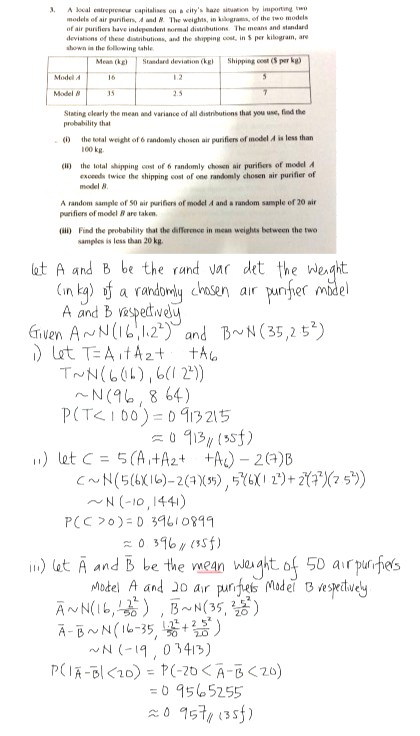
 360 Tutoring Program
360 Tutoring Program
*If you qualify, the Free 360 Tutoring Program will be extended to you at no extra charge.
On top of the tutor you are getting, ManyTutors will provide unlimited free tutors to help you with any questions you may have for other subjects. Just snap a photo of your homework, post, and someone will provide the solution for free.
You will get a complimentary premium account on Ask ManyTutors that allows you to ask English, Chinese, Malay, Math, Science, Geography and History homework questions free of charge.
Under the 360 Program, the tutor will receive a different rate from what you are paying to ManyTutors.


For part(iii), I understand it as
P(Ā - B̅ < 20) or P(B̅ - Ā < 20)
Ā - B̅ ~ N( -19, 0.3413)
P(Ā - B̅ < 20)
= 1
B̅ - Ā ~ N(19, 0.3413)
P(B̅ - Ā < 20)
= 0.9565255
= 0.957 (3s.f)
Initially I wanted to add both probabilities because or(+), but adding 1 is definitely wrong and the answer is 0.957
So why can’t I use P(Ā - B̅ < 20)? The question asked for difference of mean weight of both A and B which can go either Ā - B̅ or B̅ - Ā?
Or should I reject Ā - B̅ because the probability is 1?
since P(A bar- B bar < 20)=1, it is for *sure* A bar is more than B bar by less than 20, no need to doubt about it. So the only way to have a difference less than 20 between them lies in the hand of P(B bar - A bar < 20).
The way you listed there, is really not a recommended way to present the difference (the modulus). Firstly, you need to calculate two distribution (though simple, but not needed). Secondly, it gives you wrong interpretation as to + the two probabilities, as it looks like an "OR" cases to add them.
So, use the modulus method.
If I have to use modulus, what situations can I use it on? If the question ask for the diff between two variables is more than or less than a number? What do I need to type on my calculator or I just solve it manually?